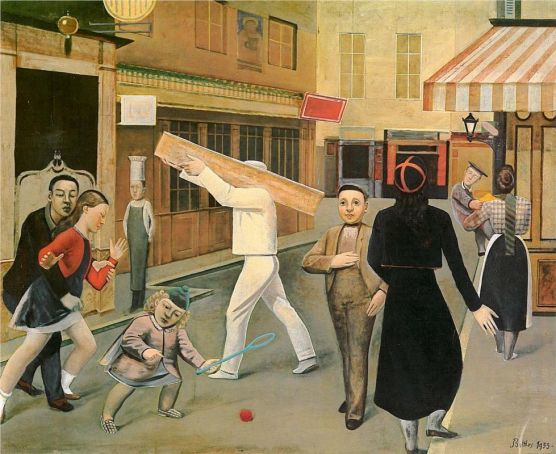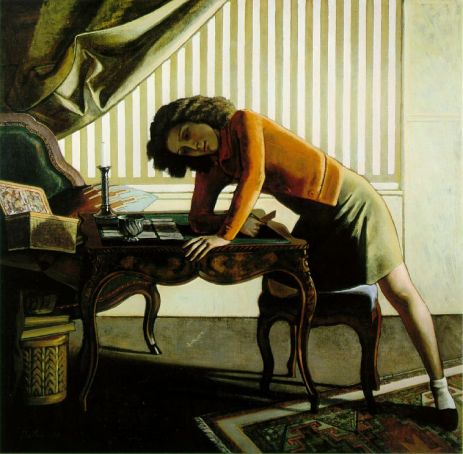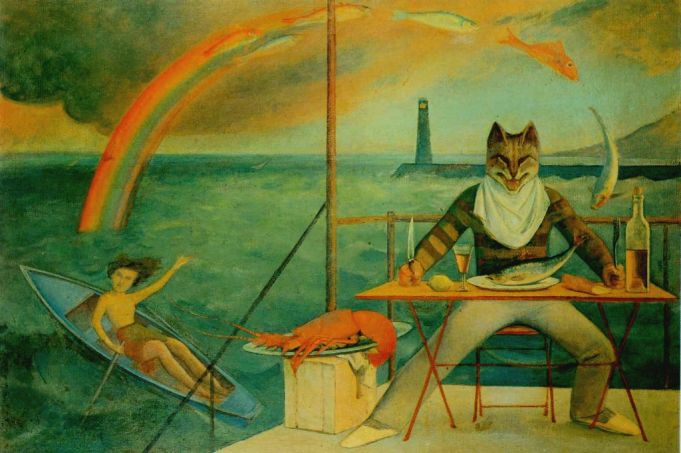24 Oct-31 Jan. Captivating, voyeuristic, unsettling, ambiguous, creepy, unique; there are many adjectives to describe the art of Balthasar Klossowski de Role, better known as Balthus (1908–2001). It is less easy, however, to pinhole the work of the Polish-French artist into any one category.
On the 15th anniversary of his death the Scuderie del Quirinale in Rome presents a major exhibition dedicated to an artist it describes as one of the “most original and enigmatic masters of the 20th century.”
The restrospective built around his best-known masterpieces is part of a joint exhibition at the Scuderie and the capital’s French Academy at Villa Medici, where Balthus was the director from 1964-1979. Between both venues there are around 200 pieces on display, including paintings, drawings and photographs.
As regular visitors will attest, the Scuderie never does anything by halves and the Balthus exhibition is no exception. It is beautifully presented. The show begins with The Street (1933) which, according to Balthus, was his “first important work”, the origin of a brave new style. Set in the Latin quarter in Paris, this large street scene caused scandal when it was exhibited in 1934, primarily due to the perceived act of sexual aggression in the far left of the painting.
Populated by strangely-frozen figures, the work has clear echoes of Early Renaissance Italian artists, in particular Piero Della Francesca, and is also influenced by children’s book illustrations. Exhibited alongside earlier versions as well as Balthus copies of Della Francesca’s Leggenda della Santa Croce fresco cycle in Arezzo, The Street contains the principal features of the artist’s future works: seemingly mundane moments of contemporary life, Old Masters’ painting techniques and, more disturbingly, his subtly erotic scenes of children and teenagers. (The artist always denied any hint of impropreity, claiming rather that his work recognised the "discomforting facts of children’s sexuality”).
A highlight of the show is Solitaire (1943), a painting that exudes menace. Half kneeling, half standing, a girl plays solitaire at an ornate card table. With the exception of the regular stipes of the wallpaper in the background, everything in this bougeois interior is askew, as if thrown off kilter by the poltergeist presence of the restless girl. Her position is awkward, unrelaxed, as if attempting to remain calm in the face of underlying rage or extreme boredom. Indeed such is the tension, one could imagine an out-of-shot murdered sibling or parent slumped on the carpet.
Another highlight is La Chambre (1952-54) whose central character – a young girl spreadeagled on a chaise lounge – is portrayed in a blatantly erotic light. The work was described as “profoundly a true Balthus” by the late art critic Edith Schloss in a 1990 issue of Wanted in Rome. Schloss sets the scene: “a dwarf child tearing open a curtain to let the sun expose a lone Lolita arched back in private ecstasy – a modern annunciation, an erotic mystery against deep spaces.” (Incidentally Balthus’s Girl With Cat featured as a cover for the 1995 Penguin edition of Lolita by Vladimir Nabokov.) For Schloss, the largely self-taught artist was a “painter par excellence” while Balthus himself put it thus: “To paint is to emerge from oneself, forget oneself, to prefer anonymity to everything, and sometimes risk not being in harmony with one’s own century and contemporaries.”
The exhibition continues with La Toilette di Cathy (1933), inspired by Emily Brontè’s 1847 novel Wuthering Heights. It features the maid Nelly attending to the deathly-pale and virtually naked Cathy, dressed in a wide-open dressing gown, while an elegantly-attired Heathcliff (with the likeness of Balthus) looks away, brooding over Cathy’s impending rendezvous with his rival Edgar Linton.
Arguably the most bizarre painting on display is The Mediterranean Cat, a feline-faced human (possibly Balthus who in addition to young girls was fixated with cats), tucking into a ready supply of fish leaping from the sea through a rainbow. Aside from being a joyous, almost psychedelic work, with metaphysical influences, it provides a welcome relief from the darker aspects of Balthus’s oeuvre.
That is not to say that the exhibition is swamped with pubescent girls, or “little Poussins” as the elusive artist described them, secreted away in their bedrooms in a state of undress. There are numerous portraits, ink studies and landscapes, many revealing the artist’s progression from his often mahogany, impasto earlier work to the smoother, lighter and crisper paintings of his later career.
Cour de ferme à Chassy (1957) is a stark, bright, wintery farmland scene while The Card Game (1973) is faded and washed out like a glorious mediaeval fresco. The show ends with Le peintre et son modèle (1980/81) which features the elderly artist with a much younger model who awaits his instructions.
There is a fine line between subject matter being compelling and taboo. Balthus treads this delicate line masterfully, with his complex blend of magnificent composition, contrived naevity and thinly-veiled devilment.
Andy Devane
This article was published in the December edition of Wanted in Rome magazine.
General Info
View on Map
Review of the month: Balthus at the Scuderie del Quirinale
Scuderie del Quirinale, Via XXIV Maggio 16, tel. 639967500.























